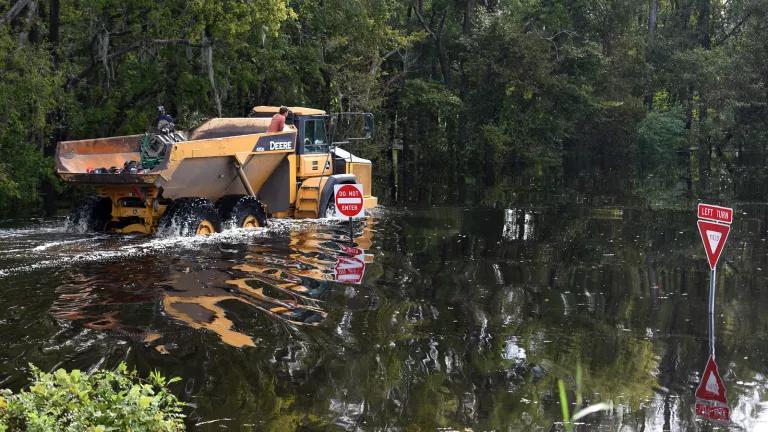Better Life: Weatherization saves low-income people money and promotes growth. Why do the Republicans want to kill it?
It was so cold in Dorothy Johnston’s trailer in Hannibal, Missouri that the retired factory worker sometimes couldn’t get out from under her covers to go to the doctor. High heating bills meant “it was a stretch to make ends meet,” she says. “I was having a hard time paying for medicines.”
Things are different now, thanks to the Weatherization Assistance Program, which uses federal tax dollars to make the homes of low-income Americans more energy efficient. “My house has just been wonderful,” Johnston says. In recent months, as temperatures dipped down into the 20s, there were no more frigid breezes blowing in through the roof and the floor. Leaky spots around the windows and doors had been caulked. As a result, she says, “I’ve been keeping my doctor’s appointments better. And even though gas is high, I have a little extra money because my utility bill isn’t so big.”
The same goes for Anthony Mooney, another WAP client, who lives in nearby Hawk Point with his partner and two of their four children. “We were eating only hot dogs and baloney,” he says. But as a result of weatherization, “last month my electric bill went from $266 to $165, and I can eat real beef sometimes.”
The federally-funded Weatherization Assistance Program saves low-income people money on their energy bills. "It is so much more comfortable now," one WAP client writes, "and I am saving on the heat even tho it's been a cold winter." The program generates more than $2 in benefits for every $1 invested.
I’ve been thinking a lot about Johnston and Mooney and people like them, as the threatened government shutdown looms. An estimated 15 million-plus households in the US are in need of weatherization services. But the program, which currently employs nearly 20,000, is on the chopping block as the GOP asserts its spending priorities.Johnston and Mooney’s Congressional representatives, Blaine Luetkemeyer and Todd Akin, are part of the influential Republic Study Group that’s leading the charge against weatherization. They say they want to eliminate “wasteful government spending,” lest we lose the battle for prosperity.
If Luetkemeyer and Akin knew anything about energy they would realize that the battle for prosperity will be won by increasing investment in efficiency measures like weatherization, not by zeroing them out. Weatherization, in particular, creates far more jobs per energy dollar invested than does operating power plants. Imagine how many people it takes to upgrade every low-income home in the country, and then every older home, every office building and every factory. Almost a million, it turns out, according to the highly regarded consulting firm McKinsey & Co. Moreover, reducing consumers’ energy bills puts money in their pockets, money that they then spend in their local economies – like a Stimulus package, but with a far lower impact on the Treasury. In fact, WAP saves low-income households an average of $437 a year, which they tend to spend on necessities like food and medicine.
In total, WAP generates well over $2 in benefits for every dollar invested. Which is why one energy researcher told the NRDC, “if you want to rebuild the economy, cutting WAP is like shooting yourself in the foot.” (That researcher declined to go on record, fearing a loss of federal research funding.) Indeed, the financial benefits of weatherization—and the environmental ones as well—extend out from the individual household to the surrounding community, and then to everyone. But first let’s focus on the poor, who get little attention these days, despite their growing numbers: Because weatherized households save so much on energy, they’re less likely to owe money on their utility bills, less likely to have their utility service cut off, and less likely to become homeless for failing to pay their rent and utility bills in full. You’d think that promoting this kind of self-sufficiency would find some appeal among conservatives.
Call me crazy, but I think this kind of stability, and the social benefits it creates, is something we as a nation should embrace. Researchers have connected energy assistance programs to decreases in school drop-out rates among low-income kids, and to reductions in the numbers of babies born at low birthweights. Their mothers aren’t forced during pregnancy to choose between paying for food and paying for heat.
In low-income communities, weatherization creates jobs—more than 50 jobs per $1 million invested, according to the US Department of Energy. And the lower electricity demand that results from weatherization means fewer illness-inducing power plant emissions are released into the poor communities where power plants are often sited. That, in turn, means fewer doctor visits, fewer emergency room visits, and fewer hospitalizations for respiratory and heart ailments linked to power-plant pollution. All of us are healthier as a result. And we taxpayers save money, too, because a large fraction of those medical services are underwritten by us.
The benefits of weatherization accrue further by preventing utility rate increases. After all, it’s bill-paying customers—you and me—not utility companies themselves, who cover utilities’ financial losses when low-income people can’t pay high energy bills. We save additional money when utilities don’t need to build expensive and polluting new power plants to meet rising energy demand.
All in all, weatherization is a boon to prosperity and to budget-cutting efforts.
Which leads me back to where I began: the budget crisis. There are more than $200 billion in federal subsidies to polluting industries that the Republicans could cut if their real interest were in wasteful government spending, promoting economic growth and increasing American global competitiveness.
Weatherization is not one of them. “I would recommend weatherization to everybody,” Dorothy Johnston says from the comfort of her recently weatherized home; I couldn’t agree more. “Everybody who needs it should have it.”



